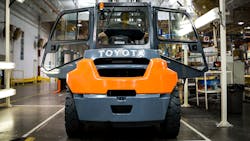Toyota Material Handling’s E-Commerce Strategy Paying Off
Savvy companies are adept at leveraging their strengths to meet changing demands.
And that’s just what Toyota Material Handling, USA Inc. (TMH), one of the largest manufacturers of industrial equipment, did when it saw that pure-play e-commerce companies were moving into the aftermarket parts business and doing well.
This was a wake-up call for the company to up its game and push forward more quickly with their digital transformation strategy.
“There are two different avenues when it comes to using e-commerce for the aftermarket business,” explains Nick Ostergaard, manager of digital transformation for TMH. “You can get into the direct selling game, or you can figure out a way to leverage your expertise. Because we have a strong reputation with a large customer base, we wanted to make sure that our customers were dealing with us, and not a third-party when it came to this area of the business.”
Rather than customizing its current e-commerce platform, TMH chose to work with Mirakl, a solution provider’s platform. “Partnering with Mirakl was a way to avoid any channel conflict, and also a good way to leverage the strength of our dealerships,” says Ostergaard.
Then in 2019, TMH launched its B2B parts online marketplace also built on the Mirakl Marketplace Platform. The portal, called MyToyotaStore, fulfills orders through the company's network of authorized material handling dealers.
“It was critical for our authorized dealers to join us online in an effort to upgrade the customer experience in the material handling industry,” says Ostergaard.
Upgrading the customer experience is especially important as the use of e-commerce is now well-established. Forrester, the consulting firm, has reported that nearly 90% of business buyers are currently purchasing through an online marketplace.
In addition to the integration of that technology into the buying cycle, those who purchase the company’s customers are increasingly younger and very adept at e-commerce. “We need to be attractive to the next generation of b2b buyers who have grown up with online ordering,” says Ostergaard.
This strategy is working for TMH as the company has seen a 220% increase year-over-year with online parts sales. And one interesting statistic is that 70% of online sales are new customers.
Of course, going digital presents challenges as well. Often mature organizations are slow to adopt new ways of doing business but Ostergaard says that trial and error is the best way to adapt to new techniques.
He offers this advice when embarking on a digital transformation. “ Make sure that you engage early and often with senior management when trying new systems,” advises Ostergaard. “Involve all areas of the organization by using an advisory council structure so that there is one source to funnel information from across the company.”
